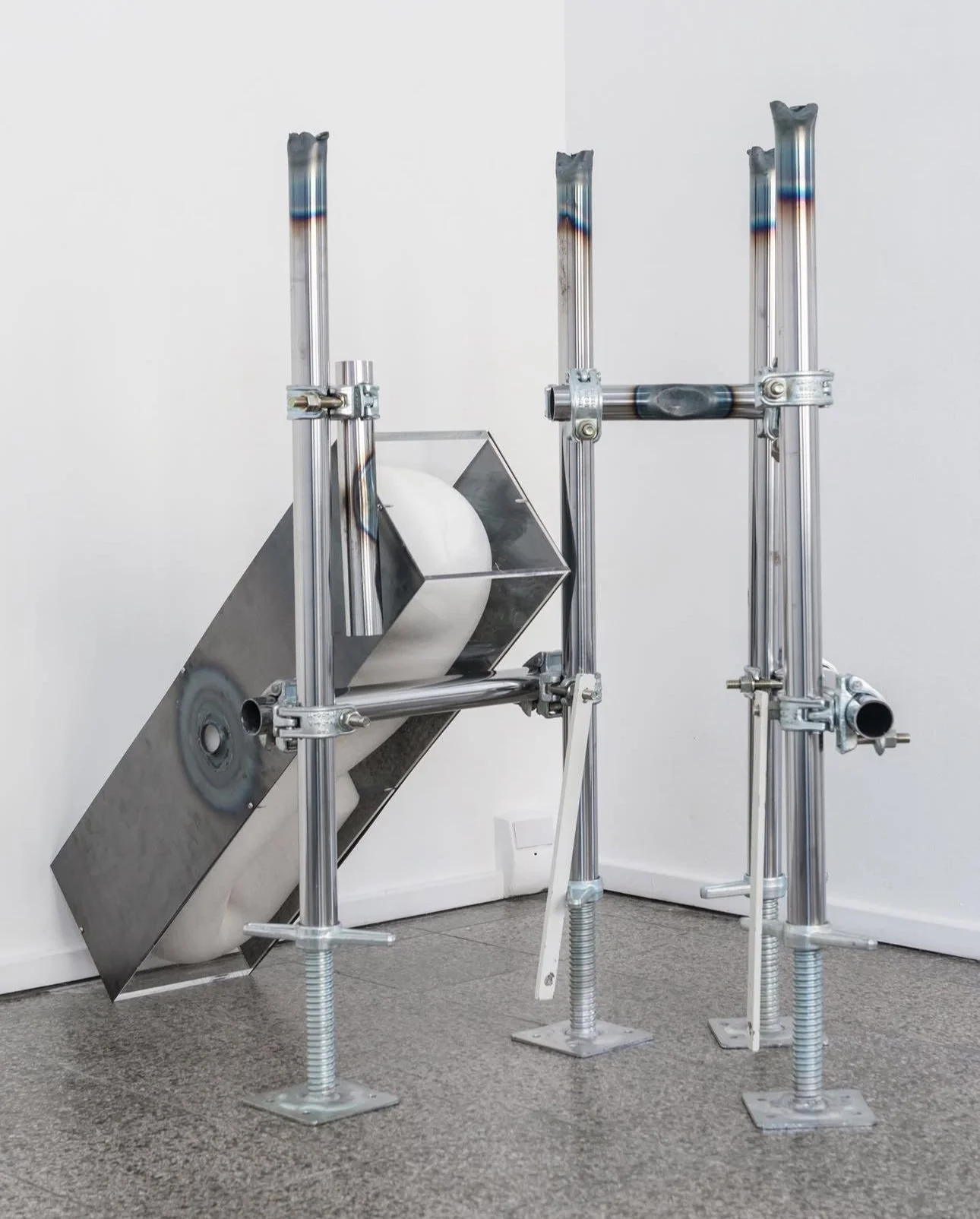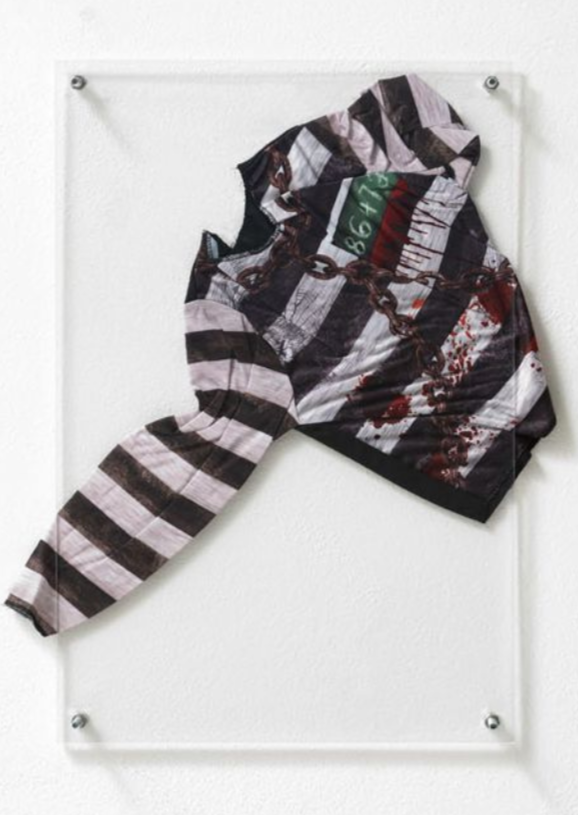Curated by Shelly Lea Reich
HYPERBOREA explores how material and objects function not just as vessels of memory but as elements that distort, erase, and reconfigure it.
Rather than simply preserving the past, materials undergo shifts that alter it meaning and presence over time.
All our works are for sale.
team@artxplus.com

NAAMA TSABAR
Israel-born, New York–based artist whose practice merges sculpture, sound, and performance, often through the deconstruction of instruments. By transforming guitars, amplifiers, and other musical tools into sculptural and participatory installations, Tsabar challenges conventions of gender, power, and collective experience. Her works often invite performers or visitors to activate them, collapsing the line between object and performance. Tsabar has exhibited internationally at Hamburger Bahnhof (Berlin, Estuaries), the Solomon R. Guggenheim Museum (New York), Palais de Tokyo (Paris), SFMOMA (San Francisco), Astrup Fearnley Museet (Oslo), and the Tel Aviv Museum of Art. Her practice has been critically discussed in Frieze, Artforum, and The New York Times.
ASSAF HINDEN
Israeli artist based between Tel Aviv and Antwerp whose work spans photography, video, and archival materials to interrogate authority, history, and identity. Through carefully staged images and experimental lens-based processes, Hinden examines the institutional gaze and the ways bodies are regulated by systems of power. His practice frequently layers historical and contemporary references, exploring how narratives are constructed and remembered. Hinden has exhibited at Braverman Gallery (Tel Aviv, Figure of Work), the Royal Academy of Fine Arts (Antwerp), and ARC Athens, and he is a graduate of Bezalel Academy of Arts and Design and the Royal Academy Antwerp. His work has been featured in Artnet and Artforum’s emerging artist roundups.
SHINOH NAM
South Korean artist based in Berlin whose sculptural practice addresses architectural collapse, instability, and human desire within social structures. Working with fragmented building materials, precarious assemblages, and performative gestures, Nam reflects on the fragility of built environments and the psychological weight of their failure. His works situate personal experience within broader contexts of oppression, power, and resilience. Nam has exhibited at Galerie Burster (Berlin), SPARK Art Fair Vienna, and most recently presented his first major solo exhibition The Collapse at Nadan Gallery (Seoul, 2025). He is a recipient of the UdK Berlin Art Award and has been featured in ArtAsiaPacific and Frieze.
Shinoh Nam, House of theOthers : Altar #5, 2022, Dimensions variable, Hand polished Steel by artist, Steel, Acryl glass, Soft sponge, Surface protect industry paint, Mirror, Unique+1AP
1900s vintage Berlin door, 1930s Hermann Hesse Narziss und Goldmund, acrylic box, mirror-polished stainless steel, door viewer, stainless steel, steel, brass 219.2(h) x 35 x 35 cm
Shinoh Nam, Doorknob: with every Doors, against my hopes and certainties, 2025, Construction steel, 6.5(h)x6 x6cm
NICOLAS LAMAS
Peruvian artist based in Europe whose installations combine found objects, scientific references, and technological fragments to question perception and systems of knowledge. Lamas frequently juxtaposes organic matter with industrial materials, creating fragile ecosystems that interrogate the instability of meaning and the human impulse to categorize. His practice is informed by philosophy and science, often destabilizing rational frameworks with poetic ambiguity. Lamas has exhibited at S.M.A.K. (Ghent), MUMOK (Vienna), MAAT (Lisbon), HOW Art Museum (Shanghai), and MoMA Warsaw, as well as solo projects with Max Goelitz (Berlin/Munich) and FORMAT (Amsterdam). His work has been reviewed in Kunstforum International, Contemporary And, and Frieze.
Kingsley Ifill
British artist whose practice spans photography, printmaking, and object-making. His work examines the tension between image, material, and memory, often transforming photographs into tactile, sculptural objects. In his Blue Roan series, Ifill combines hand-carved wooden frames with platinum-palladium prints on Japanese washi paper, drawn from over 15 years of image-making with recurring motifs such as horses, snakes, and archetypal figures. His process-driven approach — from screen-printing on raw linen to historical print techniques — imbues his works with rare material resonance. Featured in The Face, Document Journal, and Hero Magazine, his work was most recently presented in the solo exhibition Blue Roan at Hannah Barry Gallery, London (March–May 2025).
SHUANG LI
Chinese-born, Berlin/Geneva–based artist working across performance, video, and installation to explore fandom, digital culture, and the mediation of intimacy through the internet. Her practice reflects on how screens and platforms shape identity and collective desire, often merging music, subcultural aesthetics, and science fiction narratives. Li’s immersive installations collapse physical and virtual space, evoking the emotional charge of online communities. She has held solo exhibitions at the Swiss Institute (New York, I’m Not), Aspen Art Museum, Peres Projects (Berlin, nobody’s home), and Madragoa (Lisbon, Death Star). Her work has been included in group shows at the Venice Biennale and Kunsthalle Basel, and she has been profiled in ArtReview, Frieze, and Artforum.
LUKAS HEERICH
German artist based in Berlin and Paris whose multidisciplinary practice spans sculpture, sound, and installation. Heerich investigates visibility, control, and transformation by reworking industrial and architectural forms into immersive environments. His works often integrate sound and light, producing staged situations that question how perception is mediated. Heerich has presented work at Palazzo Soranzo Cappello during the Venice Biennale, Kunsthalle Düsseldorf (IM KINOSAAL), and Liste Art Fair Basel. He has also exhibited with Max Goelitz and participated in projects at institutions including Kunstverein Düsseldorf and Künstlerhaus Bremen. His practice has been discussed in Monopol, Spike Art Magazine, and Artforum.
JACK O’BRIEN
London-based artist whose practice engages installation and conceptual strategies to explore narrative, fragility, and material experimentation. O’Brien creates site-specific environments that often use ephemeral or industrial materials, drawing attention to transformation and decay in urban and social landscapes. His work reflects a sensitivity to space and temporality, often blurring the boundaries between sculpture, stage, and architecture. Winner of the Camden Art Centre Emerging Artist Prize (2023), O’Brien has presented a major solo project The Reward at Camden Art Centre, London, and participated in group exhibitions at Capitain Petzel (Berlin, Cascade) and Kestner Gesellschaft (Hanover, Cue the Cue). His practice has been profiled in ArtReview, Frieze, and Art Monthly.
Drawing from Catherine Malabou’s The Ontology of the Accident: An Essay on Destructive Plasticity, the exhibition considers how objects, like identities, are subject to irreversible transformation. Malabou describes destructive plasticity as a force that “does not produce a new form but results in a formlessness, a loss of identity.” Applied to materiality, this suggests that objects do not passively store history; rather, they exist in a constant state of flux, where memory is broken and remade.
The title Hyperborea invokes a mythical locus of eternal spring, a territory positioned beyond the reach of historical time, suffering, and decay. In classical cosmologies, it signified not simply a geographic utopia but an ontological exception: a space exempt from transformation, insulated from accident, untouched by the disfiguring force of reality. Within the context of this exhibition, however, Hyperborea becomes a conceptual provocation, a symbol less of paradise than of projection, less of hope than of denial.
Naama Tsabar, Eye U, 2021, incised New Yorker magazine 37.5x30cm (framed) - Price on request
Naama Tsabar, Eye U, 2021, incised New Yorker magazine 37.5x30cm (framed)- Price on request
Assaf Hinden, Nimrod, 2018, Photography, archival pigment print, 90x90x3.5cm- Price on request

Nicolas Lamas, Hybrid technologies assemblage, 2022 3D printer for clay, wasp nest and terracotta pottery 86x48x44cm- Price on request

1900s vintage Berlin door, 1930s Hermann Hesse Narziss und Goldmund, acrylic box, mirror-polished stainless steel, door viewer, stainless steel, steel, brass 219.2(h) x 35 x 35 cm
Shuang Li, Untitled (Prisoner), 2020, Mixed media: children’s costume, plexiglass, screws 60x40cm Unique- Price on request

Shinoh Nam, Doorknob: with every Doors, against my hopes and certainties, 2025, Construction steel, 6.5(h)x6 x6cm
Lukas Heerich, Untitled 2015, Canvas, wood, rubber, pigment, acrylic, 30x40x2.5cm- Price on request
Jack O'Brien, Galore, 2025 Silver-plated horn, spray paint, PVC plastic, aluminium armature wire, suction cups and metal cable-tie 20x12x64 cm- Price on request
Kingsley Ifill, Chrysalis, 2025, Acrylic on Linen, 140x190x4.5cm- Price on request
Kingsley Ifill, Floating on the Silence, 2025, Acrylic on Linen, 43.5x31.5x5cm- Price on request
Assaf Hinden, Nights, 2021, Photography archival pigment print, black oak frame, anti-reflective glass, 110x110cm- Price on request
David Shamie, My Death is Everywhere, My Death Dreams, 2025, Resin, burned plastic tube, augers,178x 40x40cm- Price on request














